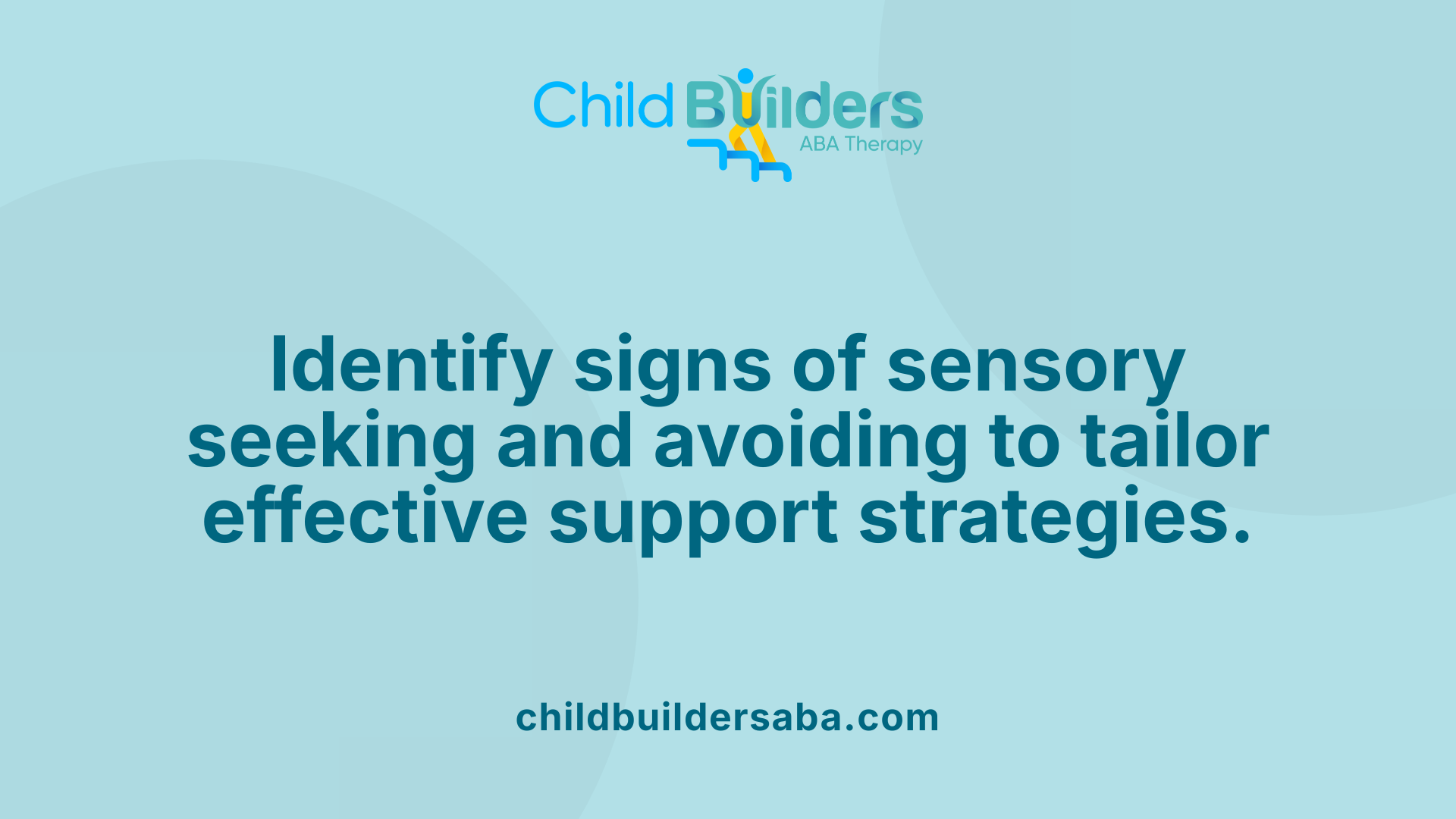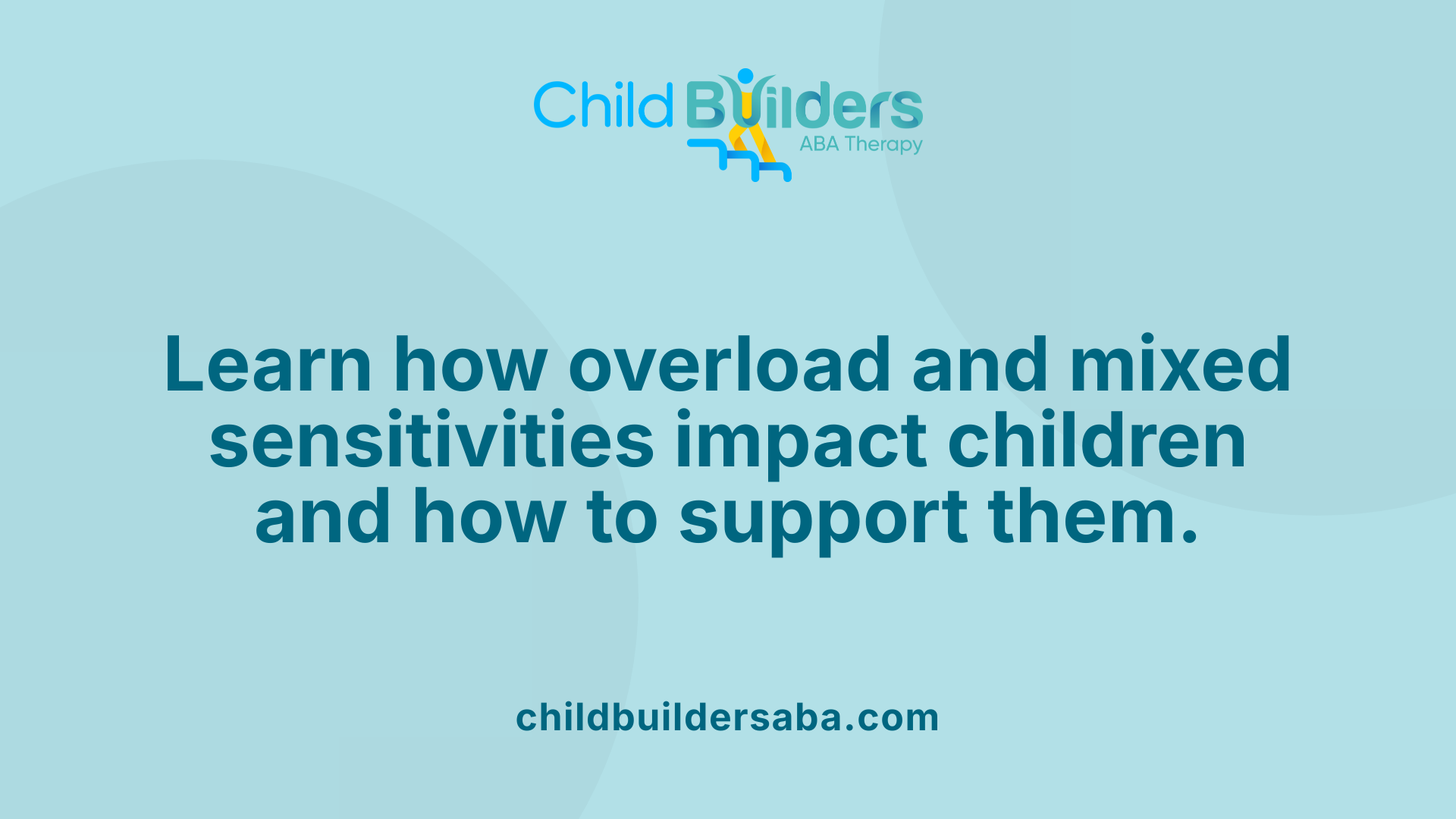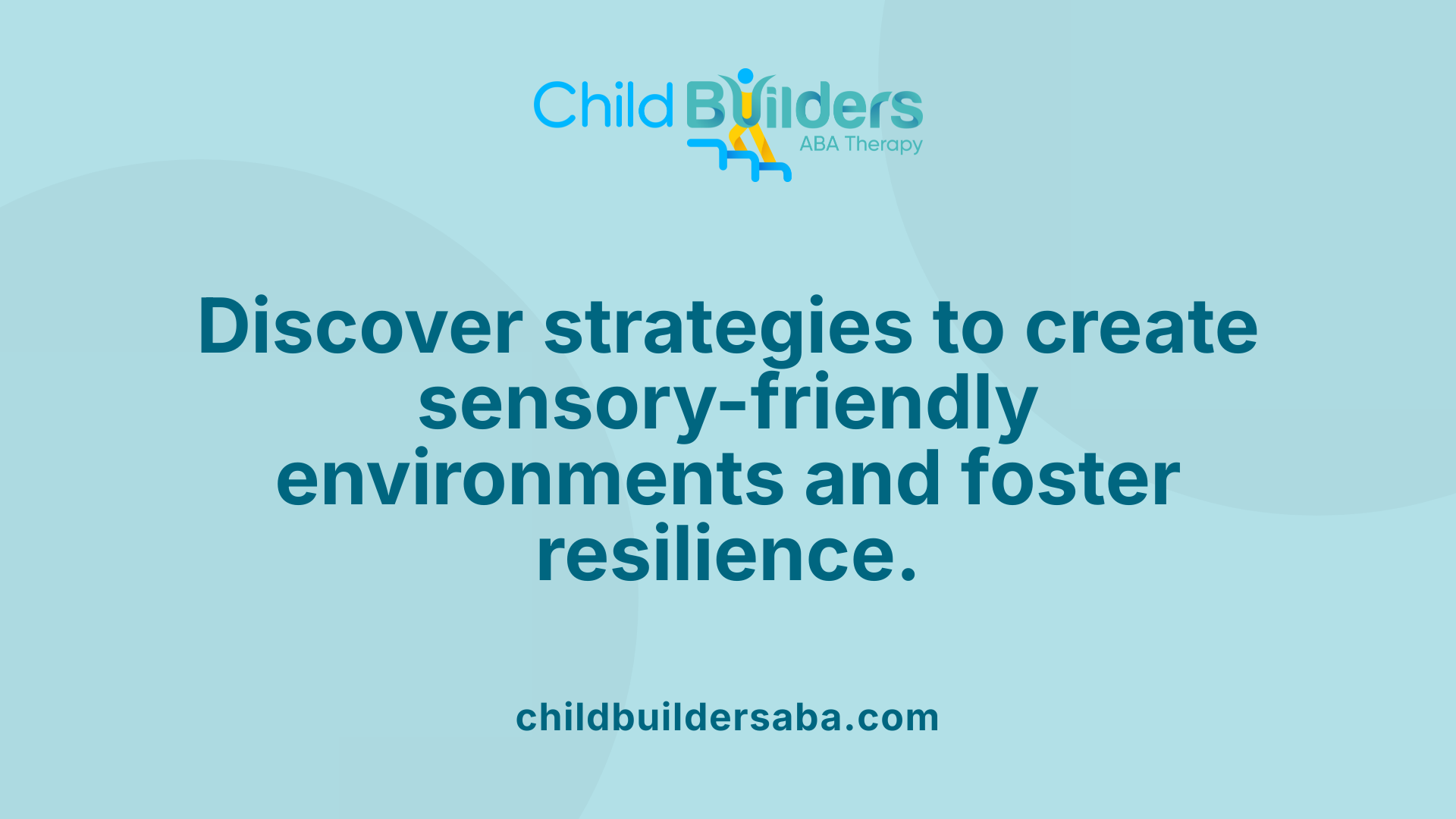Sensory Seeking vs. Sensory Avoiding in Children

Introduction to Sensory Processing in Children
Children process sensory information uniquely, which influences their behavior, emotional regulation, and how they navigate their environment. Recognizing the differences between sensory seeking and sensory avoiding behaviors is essential in supporting their development effectively. These behaviors often indicate underlying sensory processing patterns, which can be particularly evident in children with neurodevelopmental conditions such as autism spectrum disorder (ASD) or attention deficit hyperactivity disorder (ADHD). This article explores the signs, causes, and strategies for managing sensory processing differences in children.
Recognizing Sensory Seeking and Avoiding Behaviors

What are some signs of sensory seeking behaviors in children?
Children exhibiting sensory seeking behaviors are often highly active and eager to explore their environment through their senses. They tend to display constant movement, such as jumping, climbing, spinning, or rocking. These kids frequently touch, mouth, or smell objects, seeking tactile and olfactory stimulation. They enjoy loud noises, bright lights, and deep pressure activities like hugs and squeezing. Many struggle to sit still or remain calm and may appear clumsy or uncoordinated, often engaging in risky or impulsive behaviors like falling intentionally or taking daring risks on playground equipment.
Supporting sensory seekers involves creating environments rich in sensory input, encouraging movement, and providing appropriate outlets to satisfy their need for stimulation. Occupational therapy and sensory diet strategies can help these children better integrate sensory information, promoting regulation and overall well-being.
Common examples of sensory seeking behaviors in children
Some typical behaviors indicative of sensory seeking include:
- Jumping, climbing, spinning, and crashing into objects or others.
- Frequently touching, mouthing, or smelling objects and people.
- Engaging in rough play like swinging, bouncing, or bouncing.
- Constant fidgeting, watching others move, or imitating actions.
- Seeking loud sounds or intense sensory experiences.
- Chewing non-food items, such as shirt sleeves.
- Enjoying activities like swinging, spinning, or jumping. These actions help children explore their surroundings and fulfill their sensory needs, crucial for their development and regulation.
How do sensory seeking behaviors differ from sensory avoiding behaviors?
Sensory seeking and sensory avoiding are contrasting responses to sensory input. Seekers actively pursue sensory stimulation to increase arousal and achieve a sense of regulation. They often appear hyperactive and engage in behaviors like jumping, spinning, and roughhousing. Conversely, avoiders tend to be hypersensitive and experience sensory input as overwhelming. They work to minimize or escape from stimuli like bright lights, loud sounds, or certain textures.
Children with sensory seeking tendencies are typically under-responsive and crave additional input, while sensory avoiders are over-responsive and may become distressed or anxious due to excess stimuli. Some children display a combination of both behaviors—their responses depend on context and their internal level of arousal. Recognizing these differences assists in designing interventions such as sensory diets or gradual exposure programs that cater to each child's specific needs.
What is a sensory seeking behavior and what does it mean if a child is sensory seeking?
A sensory seeking behavior indicates that a child's sensory system requires more stimulation because it is under-responsive or has a high neurological threshold. These children actively seek intense sensory input such as movement, tactile sensations, or loud noises. They often display behaviors like incessant bouncing, spinning, jumping, or fingering objects — behaviors that help their nervous system self-regulate.
Such children are not calmed by additional input—in fact, they often become more dysregulated without it. Recognizing these behaviors allows caregivers and therapists to provide appropriate sensory activities like swinging, crashing, or deep pressure to help children achieve a balanced state. Being sensory seeking largely reflects a natural internal drive to meet their sensory needs and maintain emotional and physiological regulation.
How can caregivers support children who exhibit sensory seeking behaviors?
Supporting sensory seekers involves providing structured, safe outlets for their sensory needs. Practical strategies include:
- Incorporating sensory-rich activities like bouncing on a therapy ball, swinging, or jumping.
- Creating designated sensory corners filled with tactile toys, textured fabrics, or weighted blankets.
- Developing regular movement breaks infused with proprioceptive input, such as heavy work tasks like carrying objects or pushing carts.
- Offering oral sensory options such as chewing gum, chew toys, or crunchy snacks.
- Using calming tools and techniques like deep pressure hugs or tight clothes.
- Consulting with occupational therapists for personalized sensory strategies. By responding thoughtfully and systematically, caregivers can help children self-regulate, reduce meltdowns, and support their emotional development.
What causes sensory seeking behavior in children?
Sensory seeking behaviors are primarily driven by a low neurological threshold, meaning the child's nervous system requires more sensory input to feel organized and regulated. This often happens when children have decreased sensory awareness or processing difficulties, leading them to actively seek more stimulation to understand and feel connected to their environment.
Various factors can contribute, including atypical neural development, traumatic experiences during birth, nervous system imbalances, or neural injury. Sensory processing disorder is a common underlying condition in these cases.
In essence, sensory seeking behaviors are internal attempts by the child to compensate for their sensory processing deficits and to promote self-regulation. Recognizing these behaviors helps in devising appropriate interventions to support their development and ensure they feel secure and engaged in their surroundings.
Understanding Sensory Overload and Mixed Sensory Thresholds

What is sensory overload?
Sensory overload occurs when a child receives more sensory input than they can handle or process comfortably. This excess of stimuli can come from bright lights, loud noises, crowded environments, or even certain textures and smells. When overwhelmed, children might display behaviors such as covering their ears, shutting down, tantrums, or physical symptoms like crying or gagging. Sensory overload can disrupt a child's ability to focus, learn, and participate in daily activities, often leading to emotional distress or behavioral outbursts.
Sensory hypersensitivity and hyposensitivity
Children with sensory processing issues may be hypersensitive or hyposensitive to sensory stimuli. Hyposensitivity, or low registration, means the child does not notice or respond to sensory input as others do. They may seem uninterested, inattentive, or may actively seek sensory stimulation to feel more alert. These children often crave high-intensity activities like jumping, roughhousing, or loud noises.
On the other hand, hypersensitive children are overly responsive to sensory input. They might be easily distracted, irritable, or upset by bright lights, loud sounds, certain textures, or strong tastes. For example, a hypersensitive child might find clothing tags unbearable or refuse to eat foods with certain textures.
Understanding whether a child is hypersensitive or hyposensitive helps caregivers and professionals develop strategies that accommodate their specific sensory needs.
Children with mixed sensory thresholds
Some children exhibit a combination of seeking and avoiding behaviors, known as having a mixed sensory threshold. These children might seek sensory stimulation in some areas, like enjoying rough play or being physically close, while simultaneously avoiding or being overwhelmed by other stimuli, such as bright lights or loud environments.
Such behaviors underscore the importance of recognizing that sensory processing is multifaceted. For instance, a child might love touching messy or textured materials but be irritable when wearing certain fabrics or exposed to loud noises.
Children with mixed sensory thresholds benefit from interventions that balance their sensory input. Heavy work activities—like jumping, stomping, or deep-pressure hugs—are especially effective because they are highly calming for the nervous system. These activities provide proprioceptive input, which helps regulate arousal levels and supports sensory integration.
Adding calming techniques like low lighting and controlled breathing can also aid in managing overwhelm. Since children’s responses can vary depending on their arousal state, creating flexible, supportive environments is crucial.
Strategies for managing mixed sensory issues
Tailored strategies that include sensory tools—such as weighted blankets, chew devices, or noise-canceling headphones—can help children cope with their sensory environment.
Providing structured sensory breaks allows children to reset and maintain focus or emotional stability. For example, quiet zones and scheduled movement activities support self-regulation.
Working with occupational therapists can help identify specific triggers and develop personalized plans. These experts recommend integrating consistent routines, sensory diets, and gradually exposing children to challenging stimuli at tolerable levels.
Recognizing behaviors across the spectrum
Children with autism or other developmental conditions often display a range of sensory behaviors. Sensory seekers demonstrate hyperactivity, engage in loud, repetitive actions, and seek intense sensory experiences. Sensory avoiders, however, tend to withdraw from stimuli, cover their ears, or avoid crowded environments due to over-responsiveness.
Both types of responses may coexist in the same child, changing with context or emotional state. Recognizing these behaviors early helps caregivers implement appropriate strategies to support their needs.
Final notes
Creating understanding and fostering supportive environments is essential for children with sensory processing differences. Employing different sensory tools, adjusting environments, and incorporating activities that provide proprioceptive input can significantly improve their ability to function and thrive. Always consider consulting with healthcare professionals for assessment and tailored interventions.
Below is a summary table highlighting differences and strategies for sensory seeking and avoiding behaviors:
| Sensory Behavior Type | Characteristics | Examples | Support Strategies |
|---|---|---|---|
| Sensory Seekers | Underreact to stimuli, crave more input, hyperactive | Jumping, loud noises, touching objects | Heavy work, sensory tools, movement activities |
| Sensory Avoiders | Overreact, overwhelmed, hypersensitive | Covering ears, avoiding bright lights, picky eating | Calm environments, sensory tools, gradual exposure |
| Mixed Thresholds | Combination of seeking and avoiding | Love messy play but dislike certain fabrics | Proprioceptive activities, customized sensory diet |
Understanding and addressing these diverse responses helps create supportive, healthy spaces for children to grow and develop properly.
Therapeutic and Practical Interventions for Sensory Processing
What tips for sensory seekers?
Children with sensory seeking behaviors actively crave sensory input and may display actions like jumping, spinning, and loud noises to fulfill their needs. Providing appropriate sensory tools such as textured toys, fidget objects, or noise-making devices can help satisfy their sensory cravings safely.
Offering physical outlets like swinging, bouncing on a ball, or activities that involve crashing or hugging tightly are effective ways to meet their need for proprioceptive input. Creating sensory-friendly environments equipped with space for movement and suitable sensory stimuli can reduce frustration.
Structured sensory breaks incorporated into daily routines allow these children to engage in activities like jumping or rocking, which help their bodies and minds stay regulated.
It's important to recognize that these behaviors are a form of communication and regulation. Working with occupational therapists to develop personalized sensory diets ensures that children receive the right type and amount of sensory input tailored to their individual needs.
What tips for sensory avoiders?
Sensory avoiders tend to overreact to sensory stimuli like loud noises, bright lights, or certain textures, often trying to escape overwhelming environments.
Creating calming spaces with low lighting and minimal noise helps these children feel secure. Using tools such as noise-canceling headphones or earplugs can significantly reduce auditory overload.
Respecting their sensory limits is crucial; gradually introducing new stimuli in a controlled, non-threatening manner helps build tolerance over time. Visual supports like picture schedules or social stories can prepare them for sensory experiences.
Employing textured calming tools, such as soft fabrics or weighted blankets, can provide comfort. Patience and gradual exposure, paired with professional guidance, support children in coping with sensory challenges without feeling overwhelmed.
How can interventions help children with sensory processing challenges?
Interventions, particularly those involving occupational therapy and sensory integration techniques, aim to improve emotional regulation, reduce sensory overload behaviors, and foster adaptive responses.
Environmental modifications play a significant role. Introducing sensory tools like weighted blankets, chew devices, or fidget toys creates supportive spaces that promote calmness and focus.
Incorporating activities with heavy work—such as push-pull exercises, squatting, or wall pushes—helps children engage their proprioceptive system to self-regulate.
Structured routines that include movement and sensory breaks support children in achieving better focus, emotional stability, and social engagement. These strategies also help children communicate their sensory needs effectively.
Collaborative efforts involving caregivers, educators, and therapists ensure that interventions are individualized and effective, encouraging children to navigate their sensory worlds with greater confidence and resilience.
Impact of Sensory Processing Issues and Support Strategies

What are the impacts of sensory processing issues on children?
Sensory processing challenges can significantly affect a child's daily experience, influencing their behavior, emotions, learning, and social interactions. Children with sensory issues often find it hard to respond appropriately to their environment, which can lead to difficulties in focusing and participating in routines. Many display behaviors such as sensory meltdowns, tantrums, or withdrawal when overwhelmed.
Emotionally, children may experience frustration, anxiety, or mood swings as they struggle to manage sensory input. These challenges can result in social difficulties, with children feeling shy or avoiding peers due to sensory sensitivities. For example, a noisy classroom might be overwhelming, making it hard for a child to engage or concentrate. Recognizing these impacts highlights the need for tailored interventions and supportive environments. Creating adjustments in routines, providing sensory-friendly spaces, and involving professionals can help children better manage sensory overwhelming situations and succeed socially and academically.
How can caregivers and educators support children with sensory challenges?
Supporting children with sensory processing issues involves understanding their needs and creating environments that promote their regulation and comfort. Caregivers and educators can implement several strategies:
- Environmental adjustments: Use calming lighting, reduce noise levels, and provide sensory tools like noise-canceling headphones or fidget objects.
- Predictable routines: Establish consistent schedules to reduce anxiety.
- Sensory breaks: Offer regular breaks for movement or quiet time, such as jumping, stretching, or simply resting in a designated calming corner.
- Visual supports: Use visual schedules, social stories, or cues to help children understand routines and expectations.
- Tailored coping strategies: Work with occupational therapists to develop personalized plans, including heavy work activities like hugging or bouncing that help regulate sensory input.
Building awareness among staff and caregivers encourages responses that are supportive and non-judgmental. Celebrating small successes and providing choices empower children to communicate their sensory needs, creating a positive environment conducive to learning and socialization.
Why is professional intervention important?
Professional help, particularly from occupational therapists trained in sensory integration, plays a vital role in addressing sensory processing difficulties. These experts can conduct thorough assessments to identify specific sensitivities or seeking behaviors and develop individualized intervention plans.
Therapies focus on helping children develop sensory regulation skills, reducing problematic behaviors, and improving daily functioning. For example, therapists might introduce structured proprioceptive activities—such as jumping or pushing against resistance—that help calm the nervous system and improve tolerance to input.
Ongoing support from professionals ensures that strategies evolve with the child's changing needs, addressing complex behaviors like self-injury or social withdrawal. Early and consistent intervention not only enhances emotional resilience but also promotes better learning outcomes and social integration. Collaboration among parents, teachers, and therapists creates a network of support that fosters growth and positive development.
Overview of Sensory Behavior Types and Management Approaches
| Sensory Behavior Type | Description | Examples | Management Strategies |
|---|---|---|---|
| Sensory Seeker | Actively seeks increased sensory input, often hyperactive | Jumping, spinning, roughhousing, loud noises | Provide vigorous activities, sensory tools, structured breaks |
| Sensory Avoider | Overreacts to sensory stimuli, prefers calm environments | Covering ears, avoiding crowded places, picky eating | Create calming spaces, gradual exposure, sensory tools |
| Mixed Threshold | Exhibits both seeking and avoiding behaviors depending on context | Sensitive to touch but enjoys messy play | Use heavy work, predictable routines, and sensory assessments |
Understanding these behaviors allows caregivers and professionals to apply appropriate calming techniques and environmental adaptations, supporting children effectively.
Conclusion and Key Takeaways for Supporting Sensory Diverse Children

What are the differences between sensory seeking and sensory avoiding behaviors?
Children with sensory processing differences exhibit varying responses to environmental stimuli. Sensory seekers actively pursue sensory input—these children might engage in loud, rough, or stimulating activities such as jumping, spinning, or biting objects. They often seek movement, touch, and loud noises to achieve regulation, and may appear hyperactive or clumsy. Conversely, sensory avoiders tend to overreact to sensory stimuli, finding bright lights, loud sounds, or certain textures overwhelming. They may withdraw, cover their ears, or avoid noisy or crowded environments. Recognizing whether a child is seeking or avoiding sensory input is vital for developing effective support strategies, as these behaviors reflect different regulatory needs. Notably, some children display both types of behaviors simultaneously depending on their environment or mood, indicating a mixed sensory threshold.
How can caregivers and educators best support children with sensory processing differences?
Providing tailored support involves creating sensory-friendly environments and incorporating activities that help children self-regulate. Incorporating sensory diets—planned activities that include proprioceptive input like hugging, jumping, or stomping—can be calming for children with mixed sensory thresholds. Using tools such as noise-canceling headphones, fidget toys, calming lighting, and designated quiet spaces helps minimize sensory overload. Respecting individual sensory preferences is essential; some children may dislike certain textures or crowded settings, so gradual exposure and patience are crucial. Collaborating with occupational therapists enriches support plans, ensuring therapies and interventions address specific sensory needs. Educating caregivers, teachers, and peers about sensory behaviors fosters understanding and patience, creating a more inclusive environment for all children.
Why is it important to recognize mixed sensory thresholds and individual differences?
Children may not fit neatly into just
Final Thoughts: Embracing Sensory Diversity
Recognizing and understanding the sensory behaviors of children is vital in supporting their growth, emotional health, and social integration. Whether a child is a sensory seeker, an avoider, or exhibits both behaviors, tailored interventions and compassionate support can help them navigate their sensory worlds more comfortably. Employing practical strategies and consulting professionals such as occupational therapists ensure children receive the guidance and environments they need for optimal development. Embracing sensory diversity fosters empathy, patience, and respect, ultimately empowering children to thrive in all areas of life.
References
- Sensory seeking and sensory avoiding: What you need to know
- When Your Child is Sensory Seeking And Sensory Avoiding -
- Sensory Seeking vs Avoiding - Lighthouse Autism Center
- Recognizing Signs of Sensory Processing Disorder - Thrive Peds
- Four Patterns of Sensory Processing - ConnectABILITY.ca
- How To Support Your Children With Their Sensory Challenges
- Navigating Sensory Seeking and Sensory Avoiding: Understanding ...
- What is Sensory Seeking and Sensory Avoiding? - Twinkl Teaching
- Sensory Seeking vs Sensory Avoiding: What Parents Need to Know



.jpg)

































































































